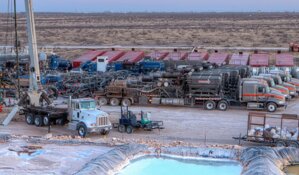TICKERS: AHGP, ATLS, APL, BWP, BGH, BPL, , EP, EPB, ENB, ETE, ET, EPE, EPD, NRGP, KMP, MMP, MWE, OKS, PVR, NYSE, SRE, SEP, , WMB
Jerry Swank: The Man with the MLP Plan
Interview
Source: Brian Sylvester of The Energy Report (10/14/10)
 Master Limited Partnerships (MLPs) are just about the most stable asset class in America, and the man with the MLP vehicles is Jerry Swank, founder and managing partner of Dallas-based Swank Capital. In this exclusive interview with The Energy Report, Jerry and Libby Toudouze, partner and portfolio manager, provide a comprehensive and insightful look at the MLP business and offer readers a bounty of MLP names.
Master Limited Partnerships (MLPs) are just about the most stable asset class in America, and the man with the MLP vehicles is Jerry Swank, founder and managing partner of Dallas-based Swank Capital. In this exclusive interview with The Energy Report, Jerry and Libby Toudouze, partner and portfolio manager, provide a comprehensive and insightful look at the MLP business and offer readers a bounty of MLP names.
Jerry Swank: I've spent my life in the investment business. I spent 14 years on the sell side at First Boston, the predecessor to Credit Suisse. During my last 10 years there, I was a director and ran the fixed-income business as a portfolio manager. Then I ran a private oil and gas (O&G) research and consulting firm called John S. Herold, Inc. I think the fact I know the energy business and the fixed income business lead me to MLPs.
When I decided to start this business in 2002, my goal was to build a Wall Street-quality research department on the buy side. We were one of the first to bring institutional-quality research to this very inefficient sector. We've grown primarily in the hedge fund business. But we've also broadened our mandate to include an MLP closed-end fund. And we have an ETN based on our Cushing 30 MLP Index. We have over $1 billion under management and are affiliated with Riverstone Holdings, the largest private equity firm in the space.
TER: Did you see quality analysis as a means to become more widely accepted as an asset class?
JS: Certainly. MLPs were a retail product. When we started, there were several MLPs that had never had serious investment analysis. The local UBS broker would just take a look at the various MLPs and buy the ones with the highest yield.
We now have models on every MLP company. We know every management team. We know the assets as well as you can from this side. That's given us a leg up.
TER: Enterprise Products Partners, L.P. (NYSE:EPD), one of the largest MLPs by market cap, recently made an offer for its general partner, Enterprise GP Holdings, L.P. (NYSE:EPE). It's become something of a trend for the parent MLP to takeover its general partner (GP). What do you think of that trend?
JS: I hate it because we own a lot of GPs and it's taking a lot of very good companies from us. I owned general partners in '02, '03 and '04—when there wasn't even a research report on them. We actually have a dedicated general partner hedge fund, Cushing GP Strategies Fund. I've had all these GPs that were stable businesses, growing their distributions at 15%–20%, which is a very attractive proposition. Hopefully, we will see some new GPs come to market.
TER: Why is it happening?
JS: The general partners own an increasing part of the cash flows of the underlying MLPs. As MLPs' distributions rise, the GPs' distributions increase at a rate anywhere from 2x–4x as fast. Because they take an increasing part of the cash flow, it has increased the cost of capital for the underlying master limited partnership. As a result, it's more difficult to do transactions, acquisitions and organic growth projects.
It happened with Magellan Midstream Partners, L.P. (NYSE:MMP). It's happening with Buckeye Partners, L.P. (NYSE:BPL) and its Buckeye GP Holdings (NYSE:BGH) and Inergy Holdings, L.P. (NYSE:NRGP). Since then, we've also had two more GP buyouts in the coal space.
It's not only the cost of capital, but there are some tax issues in the Kerry-Lieberman Energy Bill that specifically relate to individual holders of the GPs. The owners could face some tax consequences. On top of this cost-of-capital issue, I think this potential tax hit is causing this trend.
TER: But isn't it also the fundamental structure of MLPs that is causing these takeovers?
JS: Yes, that's true. In 2003, when Enterprise bought GulfTerra, it reduced the top split from 50% to 25%. I agree with the math. But it's really only when you get to the 50% splits for a long period that it's a serious problem.
On the other hand, you have Kinder Morgan Energy Partners, L.P. (NYSE:KMP), which is the second largest MLP by market cap. It took its GP private three years ago, and rumor has it the company's going to bring it public again. Rich Kinder, who really is the guy who founded the MLP business when he left Enron, steadfastly believes that he can properly grow his business in the top splits. And you can't argue because he's done a great job.
Targa Resources Partners, L.P. (NYSE:NGLS) also wants to bring its GP public. And maybe Plains All American Pipeline, L.P. (NYSE:PAA), too.
TER: You named maybe six MLPs that have bought their GPs. Should investors be buying more GPs belonging to the large MLPs?
JS: I think the trend will soon be over because of the timeframe on this tax issue. But, yes, I would take this money—and we always have—and invest it in the remaining GPs. Those are names like Energy Transfer Equity, L.P. (NYSE:ETE), Alliance Holdings GP L.P. (NASDAQ:AHGP), NuStar Energy, L.P. (NYSE:NS) and Penn Virginia Holdings L.P. (NYSE:PVG). I would invest it in those because the fundamentals of the GPs are so strong compared to the underlying MLPs.
TER: Do you own Energy Transfer Partners, L.P.'s (NYSE:ETP), GP, Energy Transfer Equity?
JS: Yes, we own Energy Transfer Partners, L.P.'s general partner, and we've been buying more. ETP has had seven or eight quarters of fairly flat earnings. It is in the natural-gas transportation business and controls most of the pipelines out of the Barnett Shale—the largest natural gas field in the United States. And ETP has great exposure to the Haynesville, which will be the biggest one. It's had rapid, rapid growth out of the Barnett for several years.
Unfortunately, because gas prices are so low, there's no differential from gas prices in west Texas and New York. You would think that gas prices in New York would be higher than they are in the middle of the west Texas desert, but the curve's been very flat. That's hurt them because they ship a lot of gas from west to east and that spread has been flat for the last year. But they've been investing billions in new pipelines, and they just had some pipelines like Tiger Pipeline coming onstream. We think you ought to be buying here because it's a getting ready to go back to a grower. We play it primarily through the GP. Although we do own some of the MLP, we own the GP because the dividend will start growing fast and it's just crazy cheap in our judgment.
TER: Which GPs are paying distributions?
JS: The remaining GPs that are paying distributions are Energy Transfer Equity and NuStar, Penn Virginia, Inergy and Alliance. The two that aren't paying dividends at this time are Crosstex Energy, L.P. Ltd. (NASDAQ:XTEX) and Atlas Pipeline Partners L.P. (NYSE:APL). They aren't paying distributions yet, but they will fairly soon. Then we have a few diversified companies that have the GPs inside of them. Those names include Atlas Energy, Inc. (NASDAQ:ATLS), El Paso Corporation (NYSE:EP), ONEOK Partners, L.P. (NYSE:OKS) and Williams Companies (NYSE:WMB), which is a very interesting play. We've always been overweighted in general partners. We've always understood the math and they've always been a great investment for us.
TER: How long should people hold the GPs?
JS: For the long term. These things have yields in the 5% range. The underlying distributions are growing at double-digit rates. And the underlying businesses are very stable. Where else would you see double-digit growth rates with absolute yields of 5% or 6%? These are the same assets, same management as the underlying MLPs; it's just a different financial structure.
TER: You own a lot of GPs, but 5% of your publicly traded portfolio is MLP bonds. If you're holding an MLP's bond, which are earning interest, and the same MLP's units, which are often paying high yields, aren't you getting paid twice? And is that the strategy behind holding them?
JS: You're one of the few guys that hit the nail on the head. MLPs pay distributions four times a year; so, in theory, you only have to own them four days a year. The rest of the time, they don't make any income. During that period, we take some of our holdings and put them in MLP bonds where we're getting +7% yields. We can earn interest on those 89 days of the month when you don't get it. So, yes that's one reason we do that. I wouldn't say it's getting paid twice, but we're using our money pretty efficiently.
TER: What are some names that you're into on both of those levels?
JS: It depends on who's in the market. We used to own the bonds of Energy Transfer, ETP. We now own the bonds of general partner ETE and Regency Energy Partners, L.P. (NASDAQ:RGNC). We've owned Plains All American and Enterprise, and recently bought some Targa bonds. It just depends on who in the market has the more attractive deal. There's not much spread left in the really strong investment-grade names like Kinder, Plains, Energy and Enterprise.
TER: MLPs are a cash-intensive business. They're paying out all of their distributions so companies need to constantly raise money in order to expand and buy other assets. In the tech sector, we've recently seen IBM and Microsoft raise literally billions with 3-year bonds. IBM's were at 1% and Microsoft's were at 0.875% per year. Do MLPs have similar access to cash right now?
JS: Yes, MLPs are voracious users of capital. That's really the only weak link in MLP story.
MLPs don't get as favorable rates because IBM and Microsoft are double A and triple A rated issuers. Because MLP balance sheets are 50% debt and 50% equity, at best they receive triple B investment grade ratings. So, instead of borrowing at 1%, we're talking about 3.5% or 4.25%.
While the spread is higher, their access to capital, debt and equity is very good right now. With these low rates, virtually all of the MLPs are funding out their bank debt with term debt.
Also with these very low levels of interest rates, returns on capital are going to be fairly high because the spreads they're making between the return on projects and the cost of debt are very wide.
TER: Are there a couple of names with some of those high-return projects that you could share with us?
JS: Yes, on aggregate, billions are being invested in the shale gas plays. We have built out most of the Barnett and the Haynesville pipeline systems. But everybody and their brother is trying to get involved in the Marcellus. MarkWest Energy Partners, L.P. (NYSE.A:MWE) probably has the best exposure.
Several companies are trying to do pipeline take-away capacity drop in the Marcellus: El Paso Pipeline Partners, L.P. (NYSE:EPB) and Spectra Energy Partners, L.P. (NYSE:SEP). These MLPs and their parent companies have been very involved in those projects. And ONEOK just announced a big project to get natural gas liquids (NGLs) out of the Bakken, which is a big oil play in Montana. But most of the large MLPs have $200–$300 million in organic projects, like small add-on pipelines or storage facilities they can do every year at attractive rates of return.
Magellan Midstream just bought a big package of assets from BP Plc (NYSE:BP; LSE:BP) in the Cushing area to add to storage. Plains All American keeps adding storage facilities, too. There's a lot of capital being spent at very good margins right now.
TER: If you include natural gas storage, 35% of your public portfolio is directly in the natural gas business. With natural gas prices obscenely low, why do you have more natural gas–related MLPs than anything else?
JS: A couple of things. We're out of the gas storage business right now because of some weak fundamentals and the shape of the gas curve.
Our MLPs have to build out the pipeline infrastructure in the shale plays. Primarily these pipelines are toll roads, especially the long-haul gas lines that get the natural gas from Texas/Louisiana to the East Coast and the Midwest. It really hasn't mattered if gas is at $4 or $10, El Paso, for example, is getting paid to move the product under long term fixed contracts.
Most of the pipelines that have been built in the last couple of years by Energy Transfer, Boardwalk Pipeline Partners, L.P. (NYSE:BWP) and Regency; almost all of these are fully committed by the oil and gas exploration and production (E&P) Companies.
It's kind of a Catch-22. On the E&P company side, these guys have continued to drill and find gas and push the price down. That's bad for their stocks. But for the guys transporting it, our toll road guys, it's good because they've had more volumes.
In the transmission business, we have El Paso, Boardwalk. These are the big guys. Enterprise Products Partners is big in the natural gas liquids. Other names include Kinder Morgan, Oneok, Sempra Energy (NYSE:SRE) and Williams. These are all large-cap MLPs. The average market cap in this space is probably $10 billion. These are stable, high quality companies.
TER: Do any of those names have specific catalysts for growth in the near term?
JS: I would say all of those names have different projects coming on. As I said El Paso is doing things in the Marcellus. Oneok is doing things with natural gas liquids and building a new pipeline out of the Bakken. Those are a couple of examples of natural gas guys that are adding capacity and growing.
TER: There have been some unfortunate pipeline accidents of late. A couple of spills have involved pipelines owned by Enbridge Energy Partners, L.P. (NYSE:EEP/EEQ). Could this be a buying opportunity for EEP?
JS: Have you been listening in on my meetings? Well, yes, Enbridge is a great buy. It's controlled by a huge Canadian utility company with a huge market cap. It's a very good company. They had some issues with a couple of leaks but they've been fixed. They have insurance; they didn't blow up the business. We very much view this weakness in Enbridge as an interesting buying opportunity.
TER: You're not worried about lawsuits?
JS: I don't think that anything that's happened is a result of huge neglect. This has got a lot of publicity because of BP's Macondo accident.
I would submit that the pipelines managed by MLPs have higher maintenance standards and are in better shape than ones run by other companies because it's the MLPs' only business.
I think you'll get more federal regulations as it relates to maintenance and things like that. But we think that will have a minor impact going forward.
TER: Another thing EEP is doing is building a pipeline out of the Bakken.
JS: Yes, EEP is building a pipeline to connect to their big main line, Lakehead. The Bakken is one of the few growing oil fields in the United States. It's a shale play. Production is 120,000 barrels a day and it will probably be 400,000 barrels a day in two years, big play. There's not enough capacity to get the oil out so you've got several people building new pipelines.
Lakehead is a few hundred miles away. EEP is building a 200- or 300-mile pipeline that they can hook into both on the Canadian and U.S. side to get the oil down to Cushing and the Gulf Coast.
TER: You're a sponsor of the Cushing 30 Index. Could you tell us a little about the Cushing 30?
JS: I'll let Libby, the creator of the ETN, contrast that against the other indexes.
Libby Toudouze: We're the sponsor and creator of the Cushing 30 MLP Index. S&P calculates and maintains it.
We designed it because there really wasn't an index out there that truly represented the asset class. The few that were out there were market cap–weighted and that gives you too much company specific risk. Five companies probably make up as much as 50% of the market cap weighted From a fiduciary standpoint; that's not a prudent way to manage a portfolio so the market cap indices are not a good benchmark. The Cushing 30 MLP Index is well diversified due to the equal weighting methodology.
Much like our active portfolio management, we developed a fundamental proprietary ranking system and basically ranked the MLP universe. The top 30 names that made the index are a great representation of the true infrastructure companies and we believe the true benchmark for the asset class. It doesn't include upstream and it doesn't include the shipping MLPs because those are a little more commodity sensitive.
We think the index will help drive some institutional flows into the MLP space. Credit Suisse launched an ETN based on this index. RBC has done some private structured notes on this index. We have several managed accounts based on the index. We've got big institutional accounts that want to swap into the index so the Cushing 30 MLP Index is really helping the asset class grow.
We have also launched the Cushing MLP High Income Index. There will be an ETN based on that index sometime later in the fall. With that index we developed a methodology to select the highest yielding MLPs. Again, with a couple of fundamental screens and you can get a 150 basis point pickup from the Cushing 30 MLP Index.
We think those are two good options to represent the asset class, depending on your focus. And, hopefully, we'll bring more money to the space.
TER: Since its inception what sort of annualized returns has the Cushing 30 had?
LT: The Cushing 30 has had a compound annual return of about 20%. Just for perspective, the closest performance by another index was I believe 17%, which was a new index that was market cap weighted but with a cap. The rest of the MLP indicies are around 15%.
JS: It makes a very representative index for portfolio managers to use.
TER: What does it mean to be a sponsor?
LT: It means that we created it and we will license it to people. And our index department maintains it.
The Cushing 30 is designed to be a static index. That seems to be a very good attribute for an index. When a name drops out, rather than re-ranking the entire index, the 29 that are still in there remain unless there are a couple of features that would kick them out. The balance of the universe is re-ranked and the number-one name goes in. That happened this year in the 3Q as WMZ was bought and PVG replaced it.
TER: Could you comment on MLPs going from something that was primarily held by retail investors to an asset class that is increasingly being held by large institutions?
JS: I'm not sure that's completely true.
First, and I've said this since 2004, this is just like the Real Estate Income Trust (REIT) business was in the 1990s. We have an asset class that looks a lot like REITs. You have real assets, real cash flows and high yields. The difference is the underlying MLP business is actually a better business than the majority of the REIT businesses were.
Finally the asset class is getting big enough that institutional money can enter. But more importantly, what I think is happening is that we're getting institutions, but the structure of the retail holding has become institutionalized. Let me explain that.
In the past these assets were 60% to 70% owned by retail. It was in your brokerage account at UBS, at Goldman, at Citibank at Morgan Stanley, etc. Your broker owned 5 or 10 of these stocks. Now with the advent of some new structures, the closed-end fund structure, the ETN structure, the retail broker is getting professional management. He's getting one statement. He's getting consolidated tax returns. No K-1s.
So he's selling those six or seven stocks and buying these funds. They're still owned by retail investors, but it's in an institutional wrapper with institutional management.
And I would define institutions as pensions, endowments, state funds etc.
LT: I'd just add that the sector's $225 billion market cap is helping. As Jerry mentioned, the different structures have really opened the doors. But when you are a pension fund or an endowment in today's environment, you've always struggled with balancing growth and income. Here is an asset class that can give you both and at high levels. You mentioned the IBM and Microsoft bonds paying 1% or less. Where can they find high yields like this plus growth? I think the fact the asset class has grown to this size is driving the pensions, endowments and foundations to take a hard look at this asset class.
TER: Thank you for talking with us today.
Jerry V. Swank has 34 years of experience in investment management and research analysis. He is the former president and CEO of John S. Herold, a 50-year-old independent oil and gas research firm. Prior to that, Jerry was director of CS First Boston and a former buy-side analyst and portfolio manager. He earned his MBA from the University of North Texas and BA in economics from Missouri University.
Libby F. Toudouze, Partner and Portfolio Manager for Swank Capital's offshore MLP funds and the Swank Best Ideas Fund, L.P. has 24 years of experience in the investment management business. Prior to joining Swank Capital, she established and ran a family office, where she developed investment policies, created an asset allocation framework and analyzed investments in both private and public markets. Libby received her BBA from Southern Methodist University and an MBA from The Cox School of Business at Southern Methodist University.
Want to read more exclusive Energy Report interviews like this? Sign up for our free e-newsletter, and you'll learn when new articles have been published. To see a list of recent interviews with industry analysts and commentators, visit our Expert Insights page.
DISCLOSURE:
1) Brian Sylvester of The Energy Report conducted this interview. He personally and/or his family own shares of the following companies mentioned in this interview: None.
2) The following companies mentioned in the interview are sponsors of The Energy Report: Atlas, Enbridge and Energy Transfer Partners.
3) Jerry Swank: I personally and/or my family own shares of the following companies mentioned in this interview: Energy Transfer Equity, Energy Transfer Partners, MarkWest Energy, Atlas and Regency. I personally and/or my family am paid by the following companies mentioned in this interview: None.
4) Libby Toudouze: From time to time, Streetwise Reports LLC and its directors, officers, employees or members of their families, as well as persons interviewed for articles on the site, may have a long or short position in securities mentioned and may make purchases and/or sales of those securities in the open market or otherwise.
Visit The Energy Report’s MLP Insights to learn more.



































